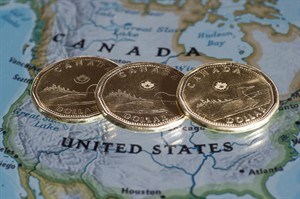
Canadian dollar coins are displayed on a map of North America January 9, 2014 in Montreal. THE CANADIAN PRESS/Paul Chiasson
Republished November 27, 2014 - 1:30 PM
Original Publication Date November 27, 2014 - 5:50 AM
TORONTO - The Canadian dollar plunged Thursday as oil prices fell below US$70 after the OPEC cartel decided not to cut production.
The loonie was down 0.75 of a cent to 88.25 cents US as the January crude contract tumbled $4.26 or almost six per cent to a 4 1/2 year low of US$69.43 a barrel late in the afternoon in electronic trading on the New York Mercantile Exchange.
There had been hopes that OPEC oil ministers meeting in Vienna would cut production in order to put a floor under prices that have fallen about 30 per cent since mid-summer, when they were elevated by geopolitical worries. Prices have steadily fallen since then on a strengthening greenback, lower demand prospects and, particularly, a glut of oil.
But OPEC said it would keep production unchanged at 30 million barrels a day
Lower oil prices are starting to bite into Canadian provincial finances. The Alberta government now expects a barrel of oil to trade at an average of US$75 a barrel for the rest of the fiscal year ending next March. Alberta's energy sector generally accounts for about 25 per cent of the province's total revenue.
It is a relatively quiet trading day on markets with American exchanges closed Thursday for the U.S. Thanksgiving Day holiday.
Gold prices also headed lower with February bullion off $7.10 to US$1,190.40 an ounce while March copper was unchanged at US$2.95 a pound.
On the economic front, there was positive trade data.
Statistics Canada reported that the country’s current account deficit on a seasonally adjusted basis narrowed by $1.5 billion in the third quarter to $8.4 billion.
During the quarter, total exports of goods rose $1.9 billion to $135 billion, despite a decline in energy products.
Overall imports of goods were up $1.3 billion to $132.1 billion in the quarter with higher volumes of precious metals accounting for half of the gain.
The current account figure is an important indicator about the health of a country’s economy, representing the difference between its savings and its investment. A positive current account balance indicates that the country is a net lender to the rest of the world, while a negative current account balance indicates that it is a net borrower.
Meanwhile, investors will also get information this week on how the overall Canadian economy is performing.
Statistics Canada releases its reading on September gross domestic product and the third quarter on Friday. Economists expect that the agency will report that GDP rose by 0.4 per cent after dipping 0.1 per cent in August, adding up to an annualized pace of 2.1 per cent.
News from © The Canadian Press, 2014